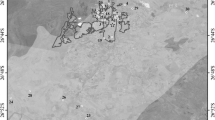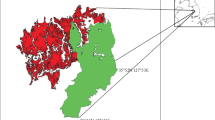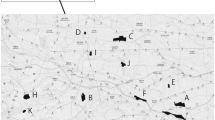Abstract
By comparing with the historic semi-natural grassland and woodland vegetation data compiled in the 1970s and 1980s, we aimed to reveal potential roles of small and linear habitat fragments remaining in the urbanized satoyama landscape (i.e., agricultural landscape) in Japan for conservation of grassland plant species. TWINSPAN cluster analysis differentiated the current vegetation from historic one. Current vegetation of Miscanthus grassland was classified into two different groups and one of the two was equivalent to current understory vegetation of fragmented woodland. The linear woodland edge vegetation along the roads was classified into one group and separated from the other current vegetation groups. The current vegetation groups were characterized by higher richness of exotic species than historic vegetation groups. Detrended correspondence analysis (DCA) revealed that there were no groups of current vegetation that is equivalent to historic woodland understory vegetation. The vegetation quality of the current group of Miscanthus grassland and secondary woodland remaining on urban public properties, and the group of linear roadside vegetation were almost equivalent to that of historic semi-natural grassland. Both of the small and linear habitat fragments might have functioned as habitats for grassland species under regular mowing management. Although small and linear habitat fragments would not be sufficient for sustaining grassland populations in the future, these habitats can serve as key reservoirs for grassland species recovery in the conservation and restoration of grassland communities in the urbanized satoyama landscape.




Similar content being viewed by others
References
Alberti M, Marzluff JM (2004) Ecological resilience in urban ecosystems: Linking urban patterns to human and ecological functions. Urban Ecosyst 7:241–265
Bolund P, Hunhammar S (1999) Ecosystem services in urban areas. Ecol Econ 29:293–301
Braun-Blanquet J (1964) Pflanzensoziologie: Grundzüge der Vegetationskunde, Vienna, Austria
Colding J, Lundberg J, Folke C (2006) Incorporating green-area user groups in urban ecosystem management. Ambio 35:237–244
Cousins SAO (2006) Plant species richness in midfield islets and road verges: the effect of landscape fragmentation. Biol Conserv 127:500–509
Cousins SAO (2009) Extinction debt in fragmented grasslands: paid or not? J Veg Sci 20:3–7
Cousins SAO, Eriksson O (2002) The influence of management history and habitat on plant species richness in a rural hemiboreal landscape, Sweden. Landscape Ecol 17:517–529
Cousins SAO, Eriksson O (2008) After the hotspots are gone: Land use history and grassland plant species diversity in a strongly transformed agricultural landscape. Appl Veg Sci 11:365–374
R Development Core Team (2011) R: A Language and Environment for Statistical Computing. R Foundation for Statistical Computing, Vienna, Austria. <http://www.R-project.org>.
Fujii E, Zinnai I (1979) Studies on the relationship between the management of floor layers and the succession of Pinus plain forests in Kanto region. J Jap Forest Soc 61:76–82 (in Japanese with English abstract)
Fukamachi K, Oku H, Nakashizuka T (2001) The change of a satoyama landscape and its causality in Kamiseya, Kyoto Prefecture, Japan between 1970 and 1995. Landscape Ecol 16:703–717
Godefroid S (2001) Temporal analysis of the Brussels flora as indicator for changing environmental quality. Landscape Urban Plan 52:203–224
Hill MO (1979a) DECORANA - A Fortran program for detrended correspondence analysis and reciprocal averaging, Ecology and Systematics. Comell University, Ithaca
Hill MO (1979b) TWINSPAN - A Fortran program for arranging multivariate data in an ordered two-way table by classification of the individuals and attributes. Comell University, Ithaca
Himiyama Y (1995) Kokudo riyou henka no gaiyou (Outlines of national landuse changes). In: Nishikawa O (ed) Atlas - environmental changes in modern Japan. Asakura shoten, Tokyo, pp 1–16 (in Japanese)
Hothorn T, Bretz F, Westfall P (2008) Simultaneous Inference in General Parametric Models. Biometrical J 50:346–363
Hovd H (2008) Extensively managed strips in intensively cultivated grasslands as possible contributors to increased plant species richness. Acta Agr Scand B-S P 58:43–50
Ide M (2006) Relationships of rural landscape structure and biological diversity in Landscape Ecology. Landscape Ecol Mgmt 10:71–74 (in Japanese)
Inui T (1992) Geographical study on the use of the plain forests in the Kanto plain, Kokonshoin, Tokyo (in Japanese)
Jantunen J, Saarinen K, Valtonen A, Saarnio S (2007) Flowering and seed production success along roads with different mowing regimes. Appl Veg Sci 10:285–292
Japan Meteorological Agency (2007) Monthly Data in an Average Year (1971–2000) at the Tsukuba Meteorological Station. <http://www.data.jma.go.jp/jma/indexe.html>.
Japan Wildlife Research Center (2006) Monitoring Sites 1000, Biodiversity Center Japan, Fuji-Yoshida (in Japanese)
Koyanagi T, Kusumoto Y, Yamamoto S, Okuro T, Ide M, Takeuchi K (2007) Comparison of the species compositions between past and present semi-natural Miscanthus sinensis grassland in the Kanto plain. Landscape Res Jap 70:439–444 (in Japanese with English abstract)
Koyanagi T, Kusumoto Y, Yamamoto S, Okubo S, Takeuchi K (2009) Historical impacts on linear habitats: the present distribution of grassland species in forest-edge vegetation. Biol Conserv 142:1674–1684
Koyanagi T, Kusumoto Y, Yamamoto S, Okubo S, Iwasaki N, Takeuchi K (2012) Grassland plant functional groups exhibit distinct time-lags in response to historical landscape change. Plant Ecol 213:327–338
Kuussaari M, Bommarco R, Heikkinen RK, Helm A, Krauss J, Lindborg R, Ockinger E, Partel M, Pino J, Roda F, Stefanescu C, Teder T, Zobel M, Steffan-Dewenter I (2009) Extinction debt: a challenge for biodiversity conservation. Trends Ecol Evol 24:564–571
McCune B, Mefford MJ (1999) PC-ORD: multivariate analysis of ecological data. Version 4. User’s guide. MjM Software Design, Gleneden Beach
McGranahan G, Marcotullio P, Millennium Ecosystem Assessment (2005) Urban systems. In: Ecosystems and Human Well-Being: Current State and Trends. Island Press, Washington, pp 795–825
Ministry of the Environment (2000) The red data book, Japan – vascular plants –. Nature Conservation Bureau, Ministry of the Environment, Tokyo
Ministry of the Environment (2002) National Strategy for the Conservation and Sustainable Use of Biological Diversity (2002 Version). Ministry of the Environment, Government of Japan, Tokyo
Miyawaki A (1977) Flora of Japan. Gakken, Tokyo
Miyawaki A (ed.) (1986) Vegetation of Japan. Kanto, vol.7, Shibundo, Tokyo (in Japanese)
Miyawaki A, Suzuki K (1974) Flora of Chiba city. Chiba city, Chiba (in Japanese)
Miyawaki A, Okuda S, Suzuki K (1975) Report of vegetation survey in the district of Chihara-dai, in the south-eastern part of Chiba prefecture. Japanese public housing corporation, Tokyo
Mueller-Dombois D, Ellenberg H (1974) Aims and methods of Vegetation Ecology. John Wiley & Sons, Inc, New York
Muratet A, Porcher E, Devictor V, Arnal G, Moret J, Wright S, Machon N (2008) Evaluation of floristic diversity in urban areas as a basis for habitat management. Appl Veg Sci 11:451–460
Noordijk J, Schaffers AP, Heijerman T, Sýkora KV (2011) Using movement and habitat corridors to improve the connectivity for heathland carabid beetles. J Nat Conserv 19:276–284
Okubo K (2002) The present state in the study of biological diversity on semi-natural grassland in Japan. J Jap Grassl Sci 48:268–276 (in Japanese with English abstract)
Okubo S, Kamiyama A, Kitagawa Y, Yamada S, Palijon A, Takeuchi K (2005) Management and micro-scale landform determine the ground flora of secondary woodlands and their verges in the Tama Hills of Tokyo, Japan. Biodivers Conserv 14:2137–2157
Puppim de Oliveira JA, Balaban O, Doll CNH, Moreno-Peñaranda R, Gasparatos A, Iossifova D, Suwa A (2011) Cities and biodiversity: Perspectives and governance challenges for implementing the convention on biological diversity (CBD) at the city level. Biol Conserv 144:1302–1313
Pysek P (1998) Alien and native species in Central European urban floras: a quantitative comparison. J Biogeogr 25:155–164
Ramalho CE, Hobbs RJ (2011) Time for a change: dynamic urban ecology. TREE. doi:10.1016/j.tree.2011.10.008
Sakiyama N, Itoga R (1994) On the change of grasslands into Pine forests in the Inashiki upland. Ibaraki prefecture. Env Res Tsukuba 15:29–44 (in Japanese with English abstract)
Sakurai T (1982) Fundamental study on vegetation management and utilization forms of Pinus densiflora lowland woodland. Graduation thesis, University of Tsukuba, Tsukuba
Sandström UG, Angelstam P, Mikusinski G (2006) Ecological diversity of birds in relation to the structure of urban green space. Landscape Urban Plan 77:39–53
Sattler T, Duelli P, Obrist MK, Arlettaz R, Moretti M (2010) Response of arthropod species richness and functional groups to urban habitat structure and management. Landscape Ecol 25:941–954
Shoji A (2003) Landscape ecological studies for semi-natural grassland conservation. Grassland Sci 48:557–563 (in Japanese with English abstract)
Sprague DS (2001) Monitoring habitat change in Japanese agricultural systems. In: OECD (ed) Agriculture and Biodiversity – Developing Indicators for policy analysis. Publications, Paris, pp 168–179
Tait CJ, Daniels CB, Hill RS (2005) Changes in species assemblages within the Adelaide metropolitan area, Australia, 1836–2002. Ecol Appl 15:346–359
Takeuchi K (2006) Landscape Ecology. Asakura shoten, Tokyo
Takeuchi K, Brown RD, Washitani I, Tsunekawa A, Yokohari M (2003) Satoyama: The traditional rural landscape of Japan. Springer, Tokyo
The Satoyama Initiative (2010) Biodiversity and livelihoods - The satoyama Initiative concept in practice -. United Nations University Institute of Advanced Studies and Ministry of the Environment of Japan, Tokyo < http://satoyama-initiative.org/wp-content/uploads/2011/09/biodiversity_booklet_en_web.pdf>
Thiele J, Otte A (2008) Invasion patterns of Heracleum mantegazzianum in Germany on the regional and landscape scales. J Nat Conserv 16:61–71
Tikka PM, Koski PS, Kivela RA, Kuitunen MT (2000) Can grassland plant communities be preserved on road and railway verges? Appl Veg Sci 3:25–32
Werner P (2011) The ecology of urban areas and their functions for species diversity. Landscape Ecol Eng 7:231–240
Yamamoto S, Itoga R (1988) Forest forms and the distribution of Pinus densiflora plain forest in southwest part of Ibaraki prefecture. Landscape Res Jap 51:150–155 (in Japanese with English abstract)
Yamasaki H, Aoki K, Hattori T, Takeda Y (2000) Increase of species diversity due to management of vegetation in Satoyama. Landscape Res Jap 63:481–484
Acknowledgments
We thank K. Fujiwara and T. Fuji, who compiled the regional flora, for providing detailed information on the historic vegetation data. T. Nakamura kindly provided additional historic vegetation data in the study area. We also thank S. Yamada and Y. Tokuoka for helping with vegetation surveys. T. Furukawa kindly edited English and gave us informative comments to improve our manuscript. This study was financially supported by the 21st Century COE Program, Biodiversity and Ecosystem Restoration, with additional support from JSPS research fellowship to T. Koyanagi.
Author information
Authors and Affiliations
Corresponding author
Rights and permissions
About this article
Cite this article
Koyanagi, T., Kusumoto, Y., Yamamoto, S. et al. Potential roles of small and linear habitat fragments in satoyama landscapes for conservation of grassland plant species. Urban Ecosyst 15, 893–909 (2012). https://doi.org/10.1007/s11252-012-0253-4
Published:
Issue Date:
DOI: https://doi.org/10.1007/s11252-012-0253-4





